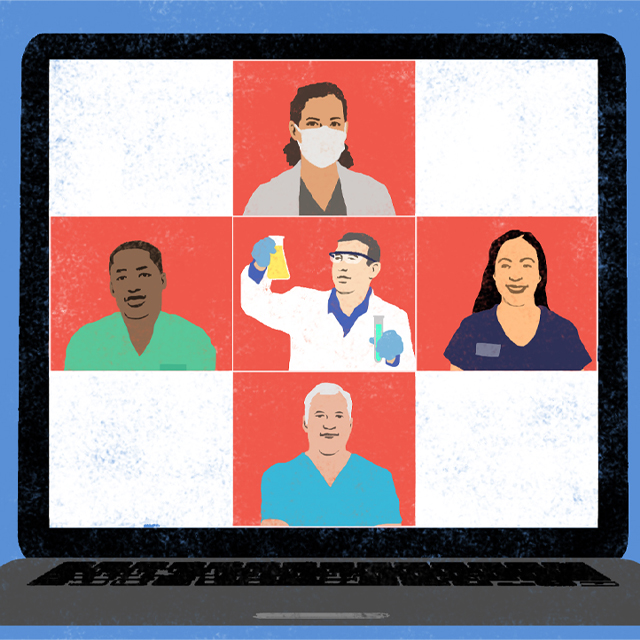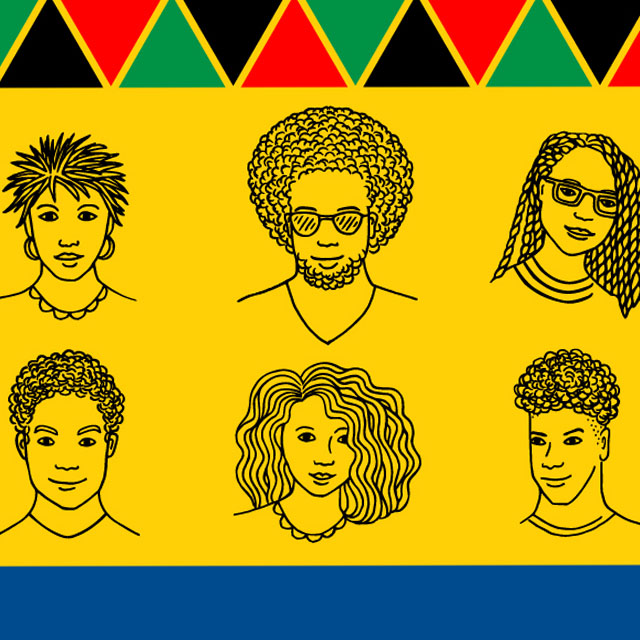(Image: Rachel Sweeney)
Grace Steward had always excelled in school, even in challenging circumstances. Diagnosed with major depressive disorder as an undergraduate, she took some time off, found effective treatments and went right back to earning top grades.
So she couldn’t figure out why she was having such a hard time early in her doctoral program at the Johns Hopkins University School of Medicine.
“I hit a wall in my research, says Steward, 24, who is studying how psychiatric disorders influence decision-making. “I couldn’t focus, and I couldn’t explain why. I was having the hardest time meeting deadlines and being organized. I was utterly distraught.”
After she failed an exam, the professor urged her to drop the class. But Steward knew she could do the work.
The obstacle, it turned out, was attention deficit hyperactivity disorder (ADHD). “I am doing better,” says Steward, who manages her additional diagnosis with medication and by sharing time-management strategies with other Johns Hopkins students with ADHD.
“I’m still learning how to integrate my new diagnosis into my life and work, but I am becoming a success story instead of a student who was disenfranchised from the program.”
The school of medicine is working to make such success stories more common for students with disabilities, chronic illnesses and mental health disorders.
“We are reframing so we’re not medicalizing disability, but instead thinking about what students with disabilities bring to our community,” says Catherine Axe, who joined The Johns Hopkins University in March 2019 as its first executive director for student disability services.
In her new role, Axe coordinates disability services across the nine schools of the university, turning a decentralized system into one that collaborates and shares resources in order to create a welcoming and accessible environment for all.
“We are looking at how we can be proactive in removing barriers instead of waiting for someone to come to us and say they need something,” she says. “That is a major shift and we’ve only just begun.”
The changes are part of a renewed diversity and inclusion effort across Johns Hopkins that seeks to celebrate the experiences and perspectives that people of all backgrounds, including those with disabilities, bring to classrooms, labs and clinics.
“We need to remove the negative stereotypes associated with disability and understand disability gives us a unique perspective,” says Bonnielin Swenor, associate professor of ophthalmology.
Swenor, who has myopic macular degeneration, is founder and director of the Johns Hopkins Disability Health Research Center, which brings together disability-focused researchers and stakeholders from throughout the university.
“We’re changing the paradigm about how disability has been viewed in clinical and research settings, as well as in society more broadly,” she says. “We’re shifting the scope from living with a disability to thriving with a disability.”
Physical, Mental, Emotional
The Centers for Disease Control and Prevention defines a disability as any condition that limits activity in some way.
“It can be physical, mental, emotional, anything,” says Kristina Nance, disabilities coordinator for masters and doctoral students in the school of medicine.
Those conditions include physical disabilities such as hearing or mobility impairments; learning or mental health disabilities such as dyslexia, autism or depression; chronic illnesses like diabetes; and injuries such as a broken ankle or concussion.
“It’s our job as people in education to help students grow,” says Ellen Kaplan, disabilities coordinator for medical students. “An accommodation is not a roadblock. It is a roadblock-remover. It allows this student who is in front of me to show what they can do.”
Though the CDC estimates that about 26% of the population has one or more disabilities, the numbers in medical school are far lower. A study by Swenor and colleagues, published in 2019, found that 4.9% of medical school students reported themselves as disabled, up from 2.9% three years earlier but still far below the general population.
The true numbers, at Johns Hopkins and elsewhere, are hard to know because many students do not report their disabilities, says Nance. The hard-driving ethos that got them to Johns Hopkins in the first place often makes it difficult for them to identify and accept help. Many school of medicine medical and graduate students simply try to work out informal accommodations such as schedule changes with their professors. Others don’t think they need support or don’t know such help is available.
Axe’s advice to students who aren’t sure they want or need disability support services: Come talk to us. She urges faculty members to deliver the same message.
“When students request something that might fall into the accommodation realm, faculty can say, ‘We have a whole office that can assist with this process.’ They can emphasize to the student that this is a confidential place where you can talk about things in a way you might not want to talk with your principal investigator.”
She gives an example of a student with a concussion who negotiated a few weeks of time off with her lab’s principal investigator, not realizing the symptoms would last for months.
“Being able to talk through the range of options with someone removed from your academic program can be very beneficial,” says Axe. “It may be easier to be more open about the challenges or impact of symptoms, and student disability services can explain options to manage or mitigate them, such as using reading technologies to reduce headache-inducing screen time.
COVID-19 Opportunities and Challenges
When COVID-19 prompted the school of medicine to close classrooms and labs in mid-March, some students welcomed the switch to remote learning. The virtual, closed-captioned lessons removed barriers for many students, including ones with disabilities related to mobility, hearing or vision.
But the sharp decrease in human interaction was potentially devastating for others, including people with depression or bipolar disorder.
“Certainly COVID-19 has changed things, whether it’s been for the better or worse depends on the person,” says Anna Moyer, co-founder of a student-led group called Equal Access in Science and Medicine. “We don’t want to force people with disabilities to work and learn from home. There are specific challenges for different groups.”
Moyer and fellow human genetics doctoral candidate Claire Bell launched Equal Access in early 2019 as an advocacy, networking and education group for trainees with disabilities, chronic illness and mental health conditions. One of its first events was a talk by Johns Hopkins psychiatry professor Kay Redfield Jamison, the acclaimed author and co-director of the Mood Disorders Clinic, about her bipolar disorder. The February event attracted about 150 people.
“We were excited that so many people were interested,” Moyer says. “We want to provide role models for disabled trainees because there aren’t a lot of people who visibly and openly disclose disabilities.”
Another member of the Equal Access group is Nicole Pannullo, who was born with moderate hearing loss and has been wearing hearing aids since preschool.
In eighth grade, her peripheral and night vision began deteriorating, and she was diagnosed with Usher syndrome type II, a genetic condition characterized by hearing loss at birth and progressive vision loss starting in adolescence.
“In a way I’m grateful to my disabilities because I don’t think I would have had the same level of motivation to succeed without them, says Pannullo, now 23 and a second-year doctoral candidate at the Johns Hopkins University School of Medicine.
“I grew up with an internalized feeling of insecurity and inferiority and felt the need to compensate by excelling academically,” says Pannullo, who is studying retinal diseases in the Cellular and Molecular Medicine Program, hoping to gain better understanding of her condition. “I don’t know if I would be studying at Johns Hopkins or in this field without my disabilities.”
She is able to read computer screens and printed paper, though she might eventually need transcription programs, she says. Because of coronavirus precautions, Pannullo can no longer read lips when she’s in the lab because her colleagues are wearing masks.
“I may ask my lab mates to wear ClearMasks,” she says, referring to the transparent masks sold by the ClearMask company, co-founded by Johns Hopkins University graduate Allysa Dittmar — deaf since birth and inspired by her experiences as a patient.
Harry Paul, a second-year M.D./Ph.D. student who is disabled, wants to see more tools like ClearMasks that ease the distinction between those with and without disabilities, and notes that researchers with disabilities are the ones to innovate them.
“Most people don’t consider nearsightedness a disability because we all have access to eyeglasses,” he says. “If we design our world in a way that using a wheelchair doesn’t keep you out of spaces, we wouldn’t even notice who uses a wheelchair.”
Paul, who used a wheelchair when he was younger, says his spinal curvature is no longer immediately visible, but it makes him more vulnerable to COVID-19 because it blocks his ability to fight respiratory infections.
“There are two options,” he says. “Keep me at home, or everyone wears a mask and stays a few feet away so I can live a normal life.”
He says inclusive policies like wearing masks to prevent the spread of COVID-19 bring more doctors and researchers with disabilities into health care. They, in turn, improve access and care for patients with disabilities.
“If we want to make our spaces less exclusionary for patients with disabilities, disabled doctors are the ones to do it,” he says.


